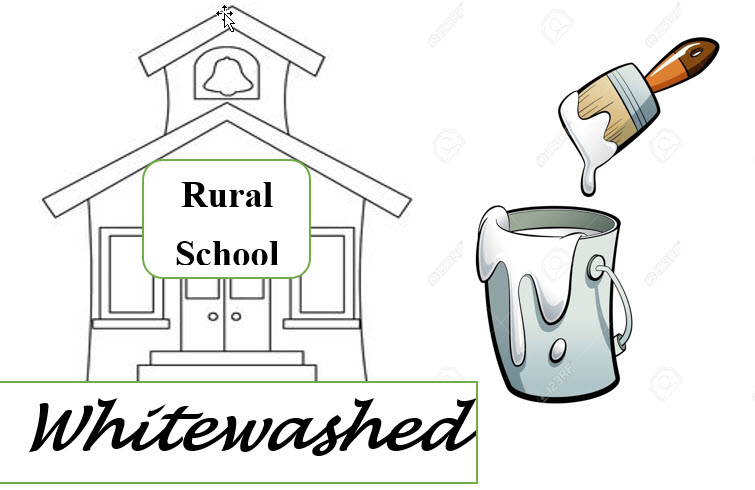Whitewashed
Rural schools suffer from lack of ethnic diversity and must find a way to compensate
In early May the student body at American University was fractured after racial tensions arose following the discovery of hanged bananas labeled with the initials of a predominantly black sorority on campus and the phrase, “Harambe Bait.” Regretfully, this hate crime isn’t merely an isolated incident, but rather, part of a larger trend playing out on campuses across the United States. This includes a noose found at a fraternity in Maryland, racist fliers marked with the phrase, “Why White Women Shouldn’t Date Black Men,” at the University of Michigan and the usage of a gorilla mask as well as blackface to intimidate students at a Black Lives Matters protest in Tennessee. Kevin Kruger of NASPA Student Affairs Administrators in Higher Education, confirms that while racist acts on college campuses certainly aren’t a new problem, the frequency seems to have surged recently. Due to the uptick of these events, students and administrators on campuses scattered throughout the nation have been grappling with how to ameliorate tensions on campus, proposing solutions ranging from increased security around black fraternities to implementing a general education requirement on diversity or even creating quotas to increase the representation of minority groups amongst the faculty.
Recent discourse at St. Olaf College highlighted that rural students and individuals from ethnically homogenous areas are rendered unprepared for the diversity they will encounter in college, pointing out that the onus to find a solution cannot not fall solely on institutions of higher learning. High schools, especially those lacking in diversity, must also do their part in educating empathetic and accepting students that are prepared to engage respectfully within a diverse world. Equipping students with these skills will become progressively necessary, as the Census Bureau projects that by the year 2100, the minority population will become the majority with non-Hispanic whites making up only 40 percent of the U.S. population. At the same time that the United States is becoming increasingly more heterogeneous, schools still lack the tools to teach about this diversity. According to a study by the National Comprehensive Center for Teacher Quality, while 76 percent of new teachers have received training on how to teach an ethnically diverse student body, less than 40 percent feel this training was actually helpful.
Rural schools face an enhanced challenge: how to respectfully teach about diversity to a group of students who may have never encountered it before. Indeed, The Education Alliance at Brown University finds that only 44 percent of America’s English as second language students live in rural areas, further concluding, “Rural teaching does not reflect the diversity of most of America.” This incongruity intensifies the struggle to teach rural students about other races and cultures. Matthew Lynch Ed.D, award winning writer and editor of The Edvocate, explains that the larger the disparity between complexities of the real world and the microcosmic school environment the student inhabits, the less comfortable students are with interacting with different ethnicities and the more fear they harbor. As exhibited by the rash of incidents on college campuses, this fear can too often also breed hate.
In order to confront this gap in student’s education, rural educators must get creative and including multiculturalism into their curriculum wherever possible. Teachers can do this by incorporating Dr. James A Banks’ Five Dimensions of Multiculturalism: integration, knowledge construction, equity pedagogy, prejudice reduction and lastly empowering school culture as well as social structure. Three of which are especially important to use in a rural area. First, integration involves putting minority contributions to a given subject into the curriculum, or alternatively, discussing the barriers different groups have faced when trying to get involved in the field. Second, knowledge construction is the process through which teachers aid students in investigating the underlying cultural biases and assumptions in the discipline. For example, realizing that the victors write history or that the Tainos would not have said Columbus discovered the Caribbean, but the Spanish did. Lastly, Banks advocates for reducing the initial prejudices the students hold. Referencing a widely respected study conducted in 1995, Banks notes that prejudice reduction need not require costly measures, but could be achieved easily, and more importantly effectively through showing videos that cast minorities in a positive light.
Policies such as these that embrace a multicultural education have tangible benefits. A national study of 25,000 students at 217 institutions conducted by Alexander Astin of the Higher Education Research Institute at UCLA, demonstrate that polices fostering cultural inclusion, such as encouraging faculty to include themes relating to diversity in their research and teaching, have a positive impact on student’s cognitive development and leadership abilities. Beyond the aforementioned benefits to the individual, multiculturalism can serve to improve society as a whole through increasing democratic participation and bolstering inclusion. Banks’ analysis confirms that for citizens to be active in a democratic society they must have the skills, knowledge and racial attitudes to build consensus with people from different ethnic backgrounds. Enabling students to build diverse coalitions that cross ethnic divides is a crucial process for democratization. In his book, “Democracy,” Charles Tilly, formerly a professor at Columbia University, writes, integrating trust networks, defined by as “ramified interpersonal connections, consisting mainly of strong ties within which people set valued, consequential long term resources and enterprises at risk to the…failures of others,” is a critical step in increasing democracy. Individuals who are engaged within these networks are able to avoid citizen state interactions and less of their will is translated into policy, therefore, decreasing democracy. Because trust networks typically fall along ethnic or socioeconomic lines, educating high school students in rural areas to feel comfortable engaging in discussions with people who are dissimilar to the in-group they have grown up with. With the Economist Intelligence Unit’s 2016 report demoting the United States from a “full democracy” down to a “flawed democracy,” processes that lead to democratization are imperative.
Additionally, students with a multicultural education are prone to be more accepting and inclusive of immigrants, refugee or other disaffected populations. Reaching out to these groups is necessary to preserve the unity of the United State and provide a buffer against deadly terrorist attacks. Take for example, Minnesota’s Somali population, which The Washington Times in 2015 noted has become a ripe target for terrorist recruiters from ISIS, Al-Shabaab and other groups with ties to radical Islamic terror organizations such as Al-Qaeda due to the isolation due to the isolation many Somali youth feel. This is not to say that every refugee or immigrant is a national security risk. In fact, quite the opposite is true. According to CNN on January 29th, 2017, no person accepted as a refugee in America has been involved in a fatal terror attack since the 1980 Refugee Act. However, the current feeling propagated by President Trump that these groups are terrorists in the making contributes to the isolation and distrust these groups feel, causing a national security threat. The effect of marginalizing these groups was demonstrated just this past February when the Washington Post reported Ka Joog, a Minneapolis based group dedicated to the integration of Somali Americans refused to accept the Federal government’s $500,000 Countering Violent Extremism grant after Trump’s xenophobic rhetoric and refugee ban. The Huffington Post finalizes that Trump has in effect handed ISIS a “a path to rebirth.” Providing a multicultural education would decrease the threat of terrorist recruitment through making students less susceptible to believing Trump’s harmful rhetoric, and more likely to adopt a welcoming attitude toward refugees. Students could take an active role in helping refugees adjust to life in America through assisting with English as a Second Language (ESL) classes. According to the Brookings Institution in 2006, refugee assistance programs, such as ESL promote soft power, which is described by Joseph Nye in his 2004 book “Soft Power” as “getting others to want what you want – it co-ops rather than coerces. Project Syndicate extends that the utilization of soft power is critical to halting recruitment by terror cells as well as drying up resources for terrorism abroad.
Despite the fact that rural students do not confront diversity on a daily basis and that racial issues may never come to a head within their high schools, it is none the less indispensable that they are equipped with a multicultural education before they even head to college. Doing so will decrease the pull of Islamic recruiters, increase democracy and instill in students the good sense that labeling bananas with the phrase “Harambe bait,” is under no circumstances ever okay.

Miranda Felton is a unicorn hunting senior. In the travel time between her two homes (Cannon Falls and Oman) she chats about international relations or...


